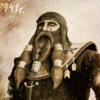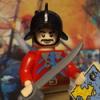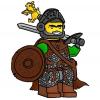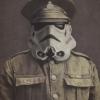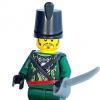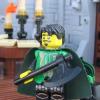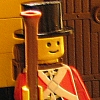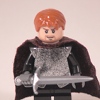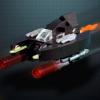Search the Community
Showing results for tags 'history'.
Found 105 results
-
JangBricks just published a superb and really complete video history of the building blocks history. I’ve seen & heard of almost all of them before, except the one made in rubber. Interesting to see how this all came what LEGO is today. Here’s the link to the video
-
- jangbricks
- youtube
-
(and 1 more)
Tagged with:
-
I love museums, particularly the Museum of Civilization in Hull, Canada (now the Canadian Museum of History) and the Field Museum in Chicago. Having recently discovered collectible Lego Minifigures (I know a bit late, but better late than never), many of which have a historical theme and Lego putting out sets based on one of my favourite cartoons growing up, that being “Scooby Doo Where Are You”, I really wanted to create a Museum that incorporated all these things. After my kids got me the Tower Bridge for my birthday I had enough Lego to attempt my own creation. So here is my version of the Knight Museum. Help the Scooby Doo gang at the Knight Museum find clues and defeat a gang of villains trying to steal precious artifacts. The first episode in the original Scooby Doo cartoon series had the gang solving the Mystery of the Black Knight in the County Museum. A secret passage (behind a portrait of the Fat Lady that leads to the roof) and various hiding places allow the villains to hide out and plan and execute their nefarious plot. This lego creation tries to combine the fantasy of Scooby Doo with beauty and treasure of real life museums. This Museum has a dinosaur exhibit, and historical exhibits from Europe, Asia, the New World, and Ancient Greeks, Romans, and Egyptians. An observatory is located on the roof for star gazing. Under the stairs is a research area, a gem display and storage for unused display items. The Museum is built on two 32x32 stud base plates and is roughly double the size of a traditional modular building. Each layer and the roof can be removed as in normal modular buildings. Hope you like it. I had fun building it. Enjoy. Museumb by Karen Metz, on Flickr Musuem4b by Karen Metz, on Flickr Museum11b by Karen Metz, on Flickr Museum6b by Karen Metz, on Flickr Museum21 by Karen Metz, on Flickr Musuem4b by Karen Metz, on Flickr Museum12b by Karen Metz, on Flickr
-
Hello everyone :) I recently completed this MOC, which is, as the title says, a WWII museum. On the left side you can see a variety of helmets and weapons (Purchased from Brickmania). In the corner there is a mini diorama that represents the battle of the bulge with two German soldiers outfitted with Winter camouflage. Two British and American soldiers (manikins) can be seen on display at the right side of the MOC. As a center display, I decided to put a willy's jeep. Anything you like or don't like? Please let me know, I am all for constructive criticism :) Thank you, Luckypat
-
Here are some buildings, I've built for Russian and Ukrainian contests Bakery Raven's Keep Graveyard Watchman's House
-
Hello from Russia! I'm happy to present you MOC about greek history (especially Greek War of Independence)! Greek revolutionist with banner. Thanks for watching!
-
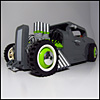
Putting the Pieces Together: A Classic Lego Collection
drdesignz posted a topic in General LEGO Discussion
An amazing classic Lego collection from 1979 to the early 90's, complete sets in their original boxes with instructions. Album with descriptions here: http://imgur.com/a/zO6qm Purchased all at once (by me) from a single collector, this is by far the best example of classic Lego history I've ever seen in one place. I've photographed and researched the entire collection. If you notice any errors or know of additional information, I'd appreciate you telling me and will update the album accordingly. Enjoy! -
My build for Round 6 of The Tourney at MOCpages. I chose to build a section of the city Harfleur, with Henry V making his triumphant entry after the town's surrender. The city's walls, towers, and houses, have all sustained damage from the siege. The only buildings set square to the base are the red house, and two small sections of the wall. Both houses have full interiors and working doors. See all the details here: link Thanks for looking
-
I decided to continue viking's theme (after my Viking's House http://www.eurobricks.com/forum/index.php?showtopic=99369&hl= ) As you know St. Olaf was the great Norway King that is regardered as a leader of Christianisation of Scandinavia
-
I'd like your input on this set I made recently: https://ideas.lego.com/projects/95531 It's based on a very famous event in US history in 1869, when the rail networks of the East and West coasts were symbolically connected for the first time with the driving of a final golden railroad spike with a silver hammer. To the best of my knowledge, this would be the first non-fictional Wild West Lego train set. The 150th anniversary of this event is only a few years away, so I figure now is as good a time as ever for Lego to release something like this.
-
Top of the morning to y'all... New published project in https://ideas.lego.com/projects/93125 for you to support should you want to :) Leave feedback and considerations regarding this MOC. Thanks! Cheers.
-
Hi! I present my own small sailing fleet in miniscale :) First part - Flotilla of the 18th century. Flotilla of the 18th century by balthazar_, on Flickr Second part - Famous ships of history. From left to right: Captain James Cook`s "Endeavour", "Mayflower", Thor Heyerdahl's "Kon-Tiki". Famous ships of the past centuries by balthazar_, on Flickr And bonus - catboat in another scale :) Catboat with sailors (~1:130) by balthazar_, on Flickr Hope you enjoyed. C&C are welcome!
-
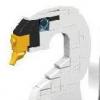
MOC: King Arthur and the Knights of the Round Table
Reekardoo posted a topic in LEGO Historic Themes
Hello! This is my new MOC (also published in lego.ideas - https://ideas.lego.com/projects/81988) Hope you like it! Let me know what you think. Cheers!- 13 replies
-
- king arthur
- castle
-
(and 6 more)
Tagged with:
-
Joan of Arc, nicknamed "The Maid of Orléans" (French: La Pucelle d'Orléans), is considered a heroine of France and a Roman Catholic saint. She was born to a peasant family at Domrémy in north-east France. Joan said she received visions of the Archangel Michael, Saint Margaret and Saint Catherine instructing her to support Charles VII and recover France from English domination late in the Hundred Years' War. The uncrowned King Charles VII sent Joan to the siege of Orléans as part of a relief mission. She gained prominence after the siege was lifted in only nine days. Several additional swift victories led to Charles VII's coronation at Reims. On 23 May 1430, she was captured at Compiègne by the allied English-Burgundian faction. She was later handed over to the English,and then put on trial by the pro-English Bishop of Beauvais Pierre Cauchon on a variety of charges. After Cauchon declared her guilty she was burned at the stake on 30 May 1431, dying at about nineteen years of age. (excerpt from wikipedia) images In this set is portrayed the escort provided to the dauphin to Orléans for his crowning. I've added some playability with the crashing tree - perfect for an english ambush. Let me know what you think Also this is posted in ideas.lego https://ideas.lego.com/projects/80187 and I'd appreciate your support
-
I've built this house only because of roof. Nothing serious but I wanted to try such technique. Moderator, add pls tag [MOC]. Thx )
-
Hi! This MOC is about the most famous battle of American civil war. Learn more about this event: --- I built defensive line which has been extended along Cemetery Ridge to the hill known as Little Round Top by Union corps under the command of Winfield Scott Hancock. --- You can find pictures of a higher quality here! More pictures: Thanks for watching! C&C are welcome!
-
In preparation for our second annual Civil War Collaboration at Brickfair Virginia, here is an introductory build, a mostly symbolic representation of the struggle between the two sides. Depending on how you interpret the build, there are 7 characteristics included that are symbolic of the real conflict. Can you spot them? For more details, click on the picture. If you are coming to Brickfair Virginia in August, stop by the Civil War collaboration and say hello! Cheers, Gary
- 14 replies
-
A couple of days ago I realized that I had built very few builds for anything besides GoH, so I decided to make something a bit different. So here is a little scene, inspired by the minifigure (I have had him built for a while) and the English Nile Expedition for the relief of Khartoum: A shot from a lower angle: And a close up of the camel and driver: Thanks for viewing, C&C are welcome
- 3 replies
-
- History
- Forced Perspective Scene
-
(and 2 more)
Tagged with:
-

Were you an AFOL before the term was coined? Before the internet?
AmperZand posted a topic in General LEGO Discussion
When I came out of my DA in the early 1990s, I didn't know there were other AFOLs. I supposed there might be but the internet was in its infancy and it didn't occur to me that there might be other collectors of historical/castle/fantasy minifigs (and buildings) that I could trace. So in my own mind, I was a pioneer: defying society's norms that adults don't buy kids' toys for themselves (except, possibly, train collectors and investors in classic toys). Is it wrong of me to take pride in being an AFOL pioneer, getting myself LEGO when I didn't know for sure that other AFOLs were out there? The other day I was in WH Smiths feeling packets for a Mr Burns from the Simpsons CMF line. The staff assumed correctly that I was looking for minifigures for myself and asked me to identify minifigs for them while I was at it which I did. What a contrast from when I used to buy LEGO from a store called Boswell's over 20 years ago and tried to make it look like I wasn't buying it for me! I probably sound like an old gasbag when I say that young AFOLs don't know how lucky they are. -
Hi everyone, Im pretty new here and seeing as there are so many amazing people on Eurobricks..... I would like some tips for a moc Im building......Marlinspike Hall from Tintin! If anyone has any reference photos or tips that would be great Its being made across 4 48 X 48 gray boards if that helps! Thank you in advance. Will update this page with pictures Bye for now, SandMirror38. UPDATE TIME!!!!!!!! Pictures!! First Up: Captain Haddock 'Blistering Barnicales' LEGO Captain Haddock by SandMirror38, on Flickr Next: Cuthbert Calculas 'A little more to the west' LEGO Calculas by SandMirror38, on Flickr And Finally....for now Thompson and Thomson 'To be precise' LEGO Thomson and Thompson by SandMirror38, on Flickr They will in the end have the same face I'm waiting on my Bricklink order and wanted to show you guys SOME of my to show this is actually happening. Tintin and Snowy would have been uploaded but I need to fix up that decal...... Thanks for everyones great support.. OVER 1220 VIEWS!!!! YEAH!!!!! I have a contact in Lego so even more support and we'll see what happens :devil: Like I have said before more pictures are coming...which means more LEGO building :wub: :wub: :blush: :sweet: Bye! SandMirror38
- 26 replies
-
- Tintin
- Marlinspike
-
(and 2 more)
Tagged with:
-
[pid][/pid] This tutorial has been sitting on my computer for ages and I only now decided to finish it and along with another project, end my micro-dark age. It’s about a piece of equipment almost as important as the ship itself: the European cannon. Please notice that while I do know a good deal about Asian Cannon and early Asian rockets I will not cover them in this tutorial! PART I – basics, material and history Cannon (from lat. Canna - “reed”) are projectile-launching weapons that were first used in the Far East and came into use in Europe during the High Middle Ages. It was the first gunpowder weapon on battlefields to be used at a large scale with effectiveness above that of a psychological impact. Although Cannon greatly varied over time and purpose in shape, composition, material, carriage and performance they still shared very distinctive features over hundreds of years. Cannon are always tubes made of metal that are mounted on a carriage (“Lafette”) and are almost always loaded via the muzzle. A gunpowder charge will be embedded between the thickest part of the cannon (the reinforce) and a cannonball. It is ignited by a fuse or a mechanism that is accessible via a small vent. The standard projectiles of cannon first were made out of stone, later metal. It quickly became common to classify cannon according to the type of projectile they could fire rather than the appearance of the actual cannon itself. A 12 pounder (a cannon capable of firing cannonballs that weighed 12 pounds) could look completely different in comparison to another 12 pounder just because one of them was being used on a ship and the other one on the field. Cannon came into use in Europe around the late 13th and early 14th century. The first major war to feature effective Cannon made of iron was the Hundred Year War. Most cannon, however, were being made from bronze at the time as this was a much more durable and reliable metal. With the propagation of improved cast iron (especially in England) in the late 15th century the European cannon got yet another material improvement and by the late 18th century almost all cannon were made from cast iron. European vessels were being equipped with cannon from at least 1330. However, designated battleships with sails came not into use until the early 16th century when the English Navy started constructing men-of-war specifically built for carrying large amounts of cannon. The first recorded purposely built gun deck was built around 1500. Until this time it was much more common to refit merchant ships like carracks, cogs, galleys and caravels into war ships if the need arose. Around the middle of the 16th century most European armies began standardizing their cannon size according to the aforementioned weight of the projectiles. Improvements in the gunpowder used and the quality of the structure of the bore allowed for smaller cannon that were actually mobile and allowed for much quicker advancing armies that could still fire over great distances. This development of siege possibilities also greatly changed the methods employed to construct fortifications (see the development of fortifications in this tutorial). While details such as transportation (limbers), aiming (trunnions) or better projectiles (cast iron projectiles) continued to increase the effectiveness of cannon they remained largely the same during the next few hundred years with the only notable exception being the mortar – a cannon designed to fire projectiles over large distances and send them across fortifications. Major change to the cannon was brought by the massive development of men-of-war in the 18th and the 19th century. The introduction of the carronade in the late 18th century supported quicker and more manoeuvrable ships: smaller, lighter Cannon being able to deliver 32 pound ordnance on short range that was able to virtually pulverize the hull of an enemy ship. Gunlocks drastically improved the speed, safety and accuracy of quickly loaded, hot cannon. In addition to improved accuracy and firing rates, new ordnance types (shrapnel shots and reliable explosive shots) brought new elements into field- and sea battle. The introduction of steel-Cannon in the mid-19th century made way for the demise of the classic cannon: although still being used until the early 20th century the cannon would eventually be replaced by steel-made field artillery and recoilless guns. PART II types and calibres This part of the tutorial will focus on cannon that were in use after the ordnance classification system had been well established. While a lot of basic cannon types will be described keep in mind that there have been well over 70 types of cannon in Europe alone and hundreds of specialized cannon series. Sakers - 4–7 pounders Sakers were relatively light cannon used en masse during the 16th century. Made from bronze they were designed for long range attacks against moving armies or fortifications. The early models still used stone ammunition but all later versions used the more modern iron ammunition. Sakers were very heavy and relied on a stable and heavy carriage due to the immense recoil the large gunpowder charge caused – thus they were used from fixed positions and were not moved during a battle. Culverins – 14-20 pounders Also used on sailing ships (merchant ships, men of war) Culverins were used from the middle to late 15th century until the early 17th century. They were made from bronze and featured a very long and thin bore (up to 5 meters) that could fire very different types of cannon balls. It was one of the first cannon to be successfully mass-produced and was able to fire cannon balls made from iron. A culverin was operated by between three and five gunners and was normally being transported on the mobile carriage with or without a limber. Mortars – 82 – 180 pounders Also used on sailing ships (bomb ketches) Mortars were used from the middle 15h century till the end of cannon. They featured a very short and large bore that looked more like a bowl than a barrel. Mortars had a high trajectory allowing for large range and the possibility to attack an enemy behind a fortification. The low velocity of the projectile also allowed for explosive rounds to be used. A mortar could be operated by two to four gunners and was very immobile due to the immense weight of cannon and ammunition. Full cannon – 42 pounders Also used on sailing ships (ships of the line) Full cannon were used during the 17th century and were normally made from cast iron. If they were to be used on a ship the preferred material was bronze in order to keep the weight lower. They were designed to take down heavy fortifications and to engage slowly moving targets at long range. On ships they were used on the top battery deck as the back bone of close range broadside attacks. Full cannon were immobile on the field and considered to be impractical due to large gunner crews of 5 to 9. Demi cannon – 32 pounders Also used on sailing ships (ships of the line, frigates) Demi cannon were used in the 17th century as a semi-accurate and close range cannon that was usually made from cast iron. The cannon required a gunner crew of at least 4 persons and would normally be used to attack advancing armies with regular shots and grapeshot attacks. Demi cannon were largely immobile due to their weight. Minions – 5 pounders Also used on sailing ships (all types of ships) Minions were the weapon of choice for close range anti-personnel attacks in the field and on ships. The small cannon was used from the 15th century till the early 18th century and could be seen as a “big brother” of the swivel gun. Minions could be carried by mobile carriage or by the gunner crew that could be 1 to 3 people. Minions were considered to be highly mobile weapons that could easily be used to defend advancing points during a battle. Howitzer cannon – 12-24 pounders Howitzers were a hybrid between regular cannon and mortars, being used from the late 17th century till the end of the age of sail. The Howitzer was mobile and could be quickly adjusted to various angles, making it a somewhat inaccurate but fast and flexible siege weapon. The Howitzer could fire a great variety of different ammunition, making it efficient in use against fortifications and army formations. A Howitzer was being operated by a gunner crew of three to 6 persons, depending on the size and the purpose of the Howitzer. Howitzers were mobile but larger versions could be difficult to move during a battle. Carronade – 6-42 pounders Mainly used on sailing ships (all types of men of war) The carronade was an immensely popular naval cannon presenting the complete range of cannon sizes. A short bore and a smaller charge chamber would fire a low velocity cannon ball with a short effective range. The low speed would damage the hull of the enemy and the deck behind it much more than high velocity ammunition. The carronade was being used from the late 18th to the late 19th century. While the short range did only allow for passing fights the high speed of the reloading process, the devastating damage and the small amount of gunners (2 to three) needed made it a perfect cannon for fast ships or ships of the line. PART III carriages, casemates and additional equipment As diverse as the cannon types were as diverse was the equipment used with them. Carriages featured large or small wheels, four or two wheels and very often no wheels at all. They would normally be transported with or on limbers that was also used to carry ammunition, cleaning equipment, aiming aids and so on. A single Culverin with equipment could need up to 4 horses to be transported. Many cannon featured different styles of trunnions that could be used to change the firing angle by adjusting the height of the muzzle. Cannon were also used in fortifications. They were often positioned on the top or within casemates. These cannon could feature very innovative carriages that were designed specifically to be able to quickly adjust the firing angle in order to compensate for the inability to move the cannon. Thank you for reading all the way down here! No go enjoy the lxf-file on cannon in LDD!
-
New cuusoo project!!! http://lego.cuusoo.com/ideas/view/61297 inspired in the book by Miguel de Cervantes :D Hope you like it and support it!!!! http://lego.cuusoo.com/ideas/view/61297
-
So now that we series 12 will include a Lincoln figure (we can debate as to why... and I don't know why I want one, but I do - maybe two or three. Abraham Lincoln: Vampire Hunter MOC anyone?), I mused in the CMF Series 12 thread about other possible figures. It could be argued that we've already gotten some - Cleopatra and Ceaser, for two, but even though I think they might specifically be those people, they weren't officially called that, and they could very well be considered in a more generic way, and you could make a an ancient Roman MOC with that figure and easily call him someone else... could be Ceaser, could be Nero, could be anyone; or a an ancient Egyptian MOC with the Pharaoh, mummy, and Egyptian woman and just call her the "Queen." But with Lincoln, we're getting down to truly specific, instantly recognizable individuals. I wouldn't mind seeing an American history sub-theme to CMFs, but know that wouldn't really go over well. Moreover, I can only think of two other instantly recognizable figures: Washington and Benjamin Franklin (especially if given a kite as an accessory). There are other worthy people - like Thomas Jefferson, but I think such a figure would come off as too generic, and he'd just be an early American aristocrat. But I got to thinking about what other historical figures that, not just being cool to have in LEGO, but would be instantly recognizable for who they were, even if needing a little context (like Franklin's kite). So what do you think? Again, this isn't supposed to be a thread about the viability of singling out specific individuals as CMFs, just a discussion about which ones you'd think would work. Since it's "historic," I'd limit it to figures from history prior to 1950. Being American I may not know how iconic some of the other historic personalities are from around the world, so now's your chance to educate me. Again, I'm not saying they should make these, but I'm just wondering who would be instantly recognizable as the individual they are. So my list is: George Washington Benjamin Franklin Adolf Hitler I would love to say people like "Geronimo," or King Henry VIII, but I think those figures would come off as too generic. I could take any King figure and call it King Henry, or the Tribal Chieftain and call him "Geronimo." Others I would think are cool would include Ghandi, Attila the Hun, Alexander the Great... but I don't think those figures would be instantly recognizable as who they are.
-
Because of work and school, I do not have a lot of time to build. Between semesters, I had a two week break to build, and this carriage was the product of that vacation. It is a minifig-scale representation of the Gold State Coach. The real one was built in England in 1762 as the ultimate ride for the Royal Family and has been used in every coronation ceremony since King George III. It has also been used for special events like royal weddings. The real carriage is beautifully ornate and gilt in gold. It's so heavy that it takes a team of eight horses to pull it! I was inspired to build this model after seeing the carousel horses in set 10235, Winter Village Market. They reminded me of the horses pulling the royal carriage. From the beginning, I wanted to build the carriage out of pearl gold and metallic gold parts. This created a big challenge because pearl gold is usually only used as an accent color in sets. As far as I know, basic bricks and plates are not available in pearl gold. A few years back, Sir Nadroj proved pearl gold could make for a stunning carriage with his "Bavarian Autumn." Since then, the number of parts in pearl gold has expanded to include the wagon wheels, minifigures, etc. The build was definitely not easy, but it was fun to see how a limited range of parts could be configured to make something recognizable. Questions, comments and criticism are welcome. For those who are interested in this project, it is on Lego CUUSOO via the following link: http://lego.cuusoo.c...deas/view/52291 More pictures can be found via my flickr account: http://www.flickr.com/photos/29934333@N02/sets/72157637177950964/with/10602636545/ This build is intended to represent the coronation of Queen Elizabeth II in 1953. She is represented by the minifig in the front. I chose this period because I used to collect toy soldiers, and one of my favorite toy soldier sets was the Britains coronation carriage released in 1953. Here is a side view of the carriage. Here is a rear-view image of the carriage. The rubber-bands on the wagon wheels are a nod to Sir Nadroj. They also give the wheels some traction! Instead of using the new carousel horses, I used rubber bands and gold coins to cover the horses heads. Pearl gold clips and rings from Lord of the Rings sets helped for decorating the horses even further. There are four Tritons (mermen) on the carriage in real-life. Fortunately, the Atlantis sets offered up the appropriate minifigure. For the Tritons in the front, the pearl gold cobra and axe-head are designed to serve as their tails. Lego doesn't make pearl gold hair, so I had to paint some. The top of the carriage features micro-minifigs, used to represent the cherubim on top of the real carriage (though the real carriage only has 3, not 4). The interior of the carriage features dark red plates to represent velvet, and it can seat one minifigure. The four ornate corners of the carriage were built using Prince of Persia helmets, pauldrons and crowns. The Tritons on the back feature "angel wings," and the bottom portion of their bodies was built using a scorpion and robot arm and 2 teeth for the tail. If you would like to learn more about the real Gold State Coach, there is an excellent video on .Thanks for taking a look, and happy building!
- 13 replies
-
- Carriage
- Royal Family
- (and 8 more)
-
Hello, Historic forum! My new creation - small vignette! It`s of course about middleages. You can find a description on Flickr! Just click on the first picture And arrow started up... by balthazar_heyward, on Flickr Master of Arms by balthazar_heyward, on Flickr Also on my Flickr photostream you can find more pictures! Click on each photo. There was Balthazzzar with you. Hope you enjoyed C&C are welcome Good Luck!
- 5 replies
-
- Vignette
- Middleages
-
(and 1 more)
Tagged with:
-
On the fateful night of July 28, 1588, the Spanish Armada, anchored off Calais (near Dunkirk) saw that the English had set out eight burners and sent them toward the closely anchored ships of the Spanish Armada... And with a bit of photo-editing: The confused Spanish ships: The exploding ship all by itself: And an English ship: Thanks for the basic boat design to Kai NRG here. Actually, I finished this a while ago, I just never got around to posting it tell now. Anyhow, this is a historical build (though afterwards I found out that none of the Spanish ships actually caught fire - they all just cut cable and ran away ). C&C are welcome, more pics at my Photostream.
- 19 replies


